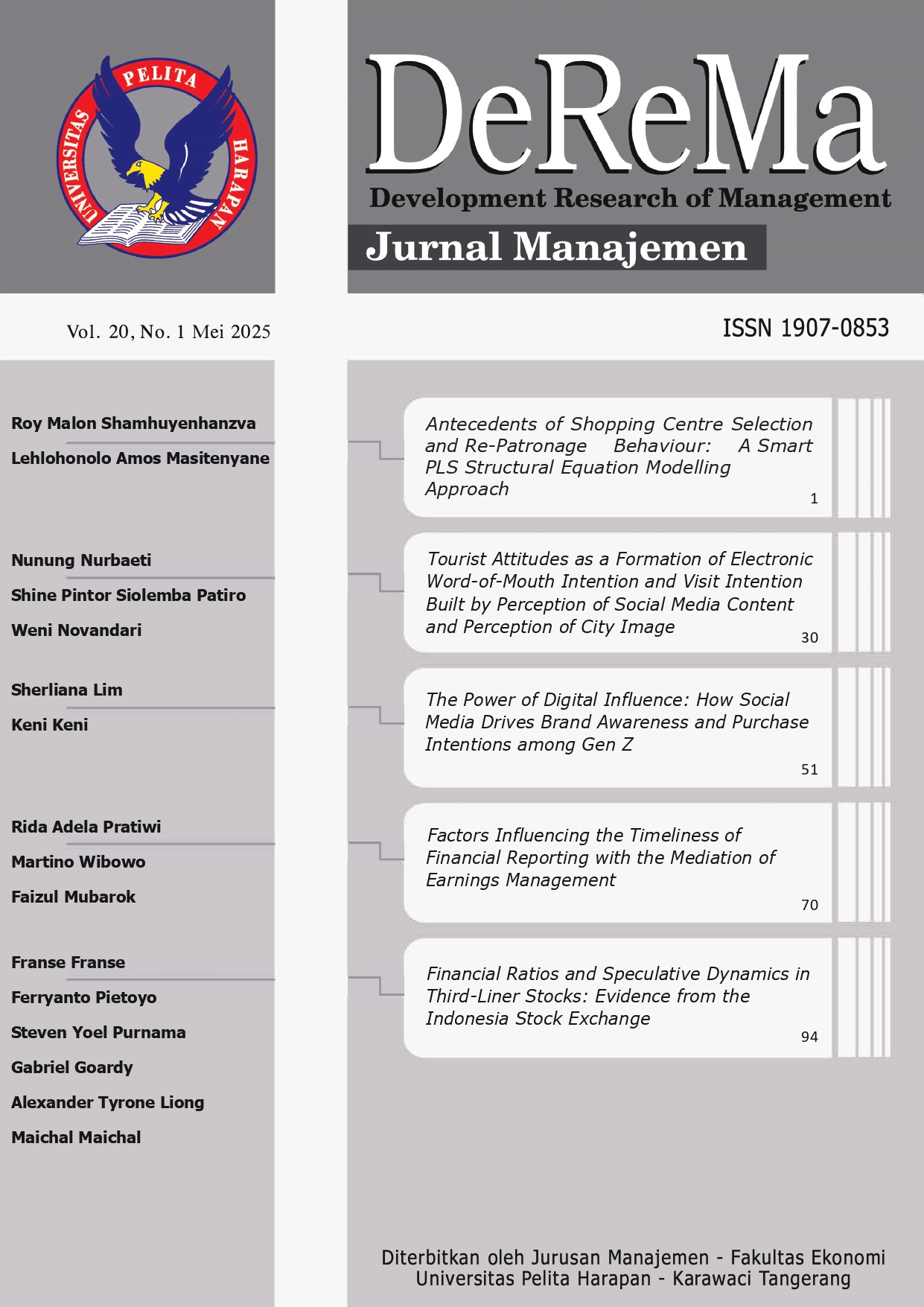TOURIST ATTITUDES AS A FORMATION OF ELECTRONIC WORD-OF-MOUTH INTENTION AND VISIT INTENTION BUILT BY PERCEPTION OF SOCIAL MEDIA CONTENT AND PERCEPTION OF CITY IMAGE
DOI:
https://doi.org/10.19166/derema.v20i1.8929Keywords:
perception of city image, tourist attitude, e-WOM intention, visit intention, perception of social media content, city image, tourismAbstract
Garut is one of the regions in West Java that has a lot of tourism potential. However, the number of tourists visiting Garut in 2014–2023 has not fully reached its target. This study aims to examine the effect of the perception of social media content and perception of city image on tourist attitude and their impact on electronic word-of-mouth (e-WOM) intentions and visit intentions. The study used a quantitative approach. The population is domestic tourists from outside Garut, who are in the provinces of West Java, Jakarta, and Banten, who in the last 3-6 months have travelled and are over 18 years old. We took the sample using the convenience sampling technique, then followed it up with snowball sampling to target 220 respondents. Data were processed using Structural Equation Modelling. This study found that perceptions of social media content and perceptions of city image affect tourist attitude. Tourists' attitude affects e-WOM intentions and visit intentions. E-WOM intentions affects visit intentions. Tourist attitude mediate the effect of perceptions of social media content and perceptions of city image on both e-WOM intentions and visit intentions. The managerial implication is that the efforts to generate tourist visit intentions are through strengthening their attitude built by perceptions of the city's image, and by encouraging their intention to actively participate in e-WOM activities related to tourism in Garut, supported by designing more attractive social media content.
ABSTRAK DALAM BAHASA INDONESIA
Garut merupakan salah satu daerah di Jawa Barat yang memiliki banyak potensi wisata. Namun, jumlah wisatawan yang berkunjung ke Garut dalam kurun waktu 2014-2023 belum sepenuhnya mencapai target. Penelitian ini bertujuan untuk menguji pengaruh persepsi atas konten media sosial dan persepsi atas citra kota terhadap sikap wisatawan serta dampaknya terhadap niat melakukan Electronic Word-of-Mouth (e-WOM) dan niat berkunjung wisatawan ke Kota Garut. Penelitian ini menggunakan pendekatan kuantitatif. Populasi penelitian adalah wisatawan nusantara dari luar Garut, yang berada di provinsi Jawa Barat, DKJ Jakarta, dan Banten, yang dalam 3-6 bulan terakhir pernah melakukan perjalanan wisata, dan berusia di atas 18 tahun. Sampel diambil dengan menggunakan teknik convenience sampling yang dilanjutkan dengan snowball sampling dengan target 220 responden. Data diolah dengan menggunakan Structural Equation Modeling. Temuan mengungkapkan bahwa persepsi atas konten media sosial dan persepsi atas citra kota memengaruhi sikap wisatawan. Sikap wisatawan memengaruhi niat melakukan e-WOM dan niat berkunjung. Niat melakukan e-WOM memengaruhi niat berkunjung. Sikap wisatawan memediasi pengaruh persepsi atas konten media sosial dan persepsi atas citra kota, baik terhadap niat melakukan e-WOM maupun terhadap niat berkunjung. Implikasi manajerial dari penelitian ini bahwa upaya yang dapat dilakukan oleh pengelola destinasi wisata di Garut untuk membangkitkan niat berkunjung wisatawan, adalah melalui penguatan sikap yang dibangun oleh persepsi atas citra kota, serta dengan mendorong niat mereka untuk berpartisipasi aktif dalam kegiatan e-WOM terkait wisata di Garut, yang ditunjang dengan merancang konten media sosial yang lebih menarik.
References
Al-Gasawneh, J. A., & Al-Adamat, A. M. (2020). The relationship between perceived destination image, social media interaction and travel intentions relating to Neom city. Academy of Strategic Management Journal, 19(2), 1-12.
Badan Pusat Statistik Kabupaten Garut (2024). Kabupaten Garut dalam Angka, Garut Regency in Figure, Volume 31
Bilal, M., Akram, U., Zhang, Y., Cai, S., & Wang, Z. (2022). Love is Blind! Exploring the impact of brand love on eWOM in Chinese hospitality industry. Frontiers in Psychology, 13, 916206. https://doi.org/10.3389/fpsyg.2022.916206
Blasco-Lopez, F., Virto, N. R., Manzano, J. A., & Delgado, D. C. (2019). Facebook’s power: Factors influencing followers’ visit intentions. Spanish Journal of Marketing-ESIC, 23(1), 95-117. https://doi.org/10.1108/SJME-06-2018-0032
Barker, C., Pistrang, N., & Elliot, R. (2002). Research Methods in Clinical Psychology (2nd ed). John Wiley & Sons. https://doi.org/10.1002/0470013435
Chaffey, D. & Ellis-Chadwick, F. (2019). Digital Marketing: Strategy, Implementation and Practice (7th ed.). Pearson Education Ltd.
Cheng, G., Cherian, J., Sial, M. S., Mentel, G., Wan, P., Ãlvarez-Otero, S., & Saleem, U. (2021). The relationship between CSR communication on social media, purchase intention, and e-wom in the banking sector of an emerging economy. Journal of Theoretical and Applied Electronic Commerce Research, 16(4), 1025-1041. https://doi.org/10.3390/jtaer16040058
Chi, N. T. K., & Pham, H. (2024). The moderating role of eco-destination image in the travel motivations and ecotourism intention nexus. Journal of Tourism Futures, 10(2), 317-333. https://doi.org/10.1108/JTF-01-2022-0014
Choirisa, S. F., Purnamaningsih, P., & Alexandra, Y. (2021). The effect of e-wom on destination image and attitude towards to the visit intention in Komodo National Park, Indonesia. Journal of Tourism Destination and Attraction, 9(1), 49-60. https://doi.org/10.35814/tourism.v9i1.1876
de Souza, J., Mendes-Filho, L., & Buhalis, D. (2020). Evaluating the effectiveness of tourist advertising to improve the competitiveness of destinations. Tourism Economics, 26(6), 1001-1020. https://doi.org/10.1177/1354816619846
Doosti, S., Jalilvand, M. R., Asadi, A., Khazaei Pool, J., & Mehrani Adl, P. (2016). Analyzing the influence of electronic word of mouth on visit intention: The mediating role of tourists’ attitude and city image. International Journal of Tourism Cities, 2(2), 137-148. https://doi.org/10.1108/IJTC-12-2015-0031
El Sheikh, S. A. H. (2020). Factors affecting pre-visit destination image: application on the Grand Egyptian Museum (GEM). Journal of Humanities and Applied Social Sciences, 2(3), 215-234. https://doi.org/10.1108/JHASS-11-2019-0075
Ferdinand, A. (2014). Metode Penelitian Manajemen. BP Universitas. Diponegoro. Semarang.
Gaffar, V., Tjahjono, B., Abdullah, T., & Sukmayadi, V. (2022). Like, tag and share: bolstering social media marketing to improve intention to visit a nature-based tourism destination. Tourism Review, 77(2), 451-470. https://doi.org/10.1108/TR-05-2020-0215
Hair, J. F., Anderson, R. E., Babin, B. J., & Black, W. C. (2010). Multivariate data analysis: A global perspective (Vol. 7). Pearson.
Han, J., & Chen, H. (2021). Millennial social media users’ intention to travel: The moderating role of social media influencer following behavior. International Hospitality Review, 36(2). 340-357. https://doi.org/10.1108/IHR-11-2020-0069
Helal, E. A., Hassan, T. H., Abdelmoaty, M. A., Salem, A. E., Saleh, M. I., Helal, M. Y., ... & Szabo-Alexi, P. (2023). Exploration or Exploitation of a Neighborhood Destination: The Role of Social Media Content on the Perceived Value and Trust and Revisit Intention among World Cup Football Fans. Journal of Risk and Financial Management, 16(3), 210. https://doi.org/10.3390/jrfm16030210
Hidayat, A., & La Are, R. (2018, March). The impact of social media as promotion tools towards intention to visit: Case of Batu, Malang, Indonesia. In 2nd International Conference on Tourism, Gastronomy, and Tourist Destination (ICTGTD 2018) (pp. 60-71). Atlantis Press. 10.2991/ictgtd-18.2018.9
Jalilvand, M. R., Ebrahimi, A., & Samiei, N. (2013). Electronic word of mouth effects on tourists’ attitudes toward Islamic destinations and travel intention: An Empirical Study in Iran. Procedia - Social and Behavioral Sciences, 81(1), 484-489. https://doi.org/ 10.1016/j.sbspro.2013.06.465
Kim, H., & Stepchenkova, S. (2015). Effect of tourist photographs on attitudes towards destination: Manifest and latent content. Tourism management, 49, 29-41. https://doi.org/10.1016/j.tourman.2015.02.004
Kim, S. B., & Kwon, K. J. (2018). Examining the relationships of image and attitude on visit intention to Korea among Tanzanian college students: The moderating effect of familiarity. Sustainability, 10(2), 360. https://doi.org/10.3390/su10020360
Kim, S., Martinez, B., McClure, C. S., & Kim, S. H. (2016). E-WOM intentions towards social media messages. Atlantic Marketing Journal, 5(1), 8. https://digitalcommons.kennesaw.edu/amj/vol5/iss1/8
Kusumawati, A., Rahayu, K. S., & Putra, E. W. (2022). Antecedents customer decision to visit Yogyakarta as special regions in Indonesia. Cogent Business & Management, 9(1), 2050062. https://doi.org/10.1080/23311975.2022.2050062
Lam, J. M., Ismail, H., & Lee, S. (2020). From desktop to destination: User-generated content platforms, co-created online experiences, destination image and satisfaction. Journal of Destination Marketing & Management, 18, 100490. https://doi.org/10.1016/j.jdmm.2020.100490
Latif, K., Malik, M. Y., Pitafi, A. H., Kanwal, S., & Latif, Z. (2020). If you travel, I travel: Testing a model of when and how travel-related content exposure on Facebook triggers the intention to visit a tourist destination. Sage Open, 10(2), 2158244020925511. https://doi.org/10.1177/2158244020925511
Lee, K. T., & Koo, D. M. (2012). Effects of attribute and valence of e-WOM on message adoption: Moderating roles of subjective knowledge and regulatory focus. Computers in Human Behavior, 28(5), 1974-1984. https://doi.org/10.1016/j.chb.2012.05.018
Lu, L., Chi, C.G. and Liu, Y. (2015). Authenticity, involvement, and image: evaluating tourist experiences at historic districts. Tourism Management, 50, 85-96. https://doi.org/10.1016/j.tourman.2015.01.026
Luo, J. M., & Ye, B. H. (2020). Role of generativity on tourists’ experience expectation, motivation and visit intention in museums. Journal of Hospitality and Tourism Management, 43, 120-126. https://doi.org/10.1016/j.jhtm.2020.03.002
Madi, J., Al Khasawneh, M., & Dandis, A. O. (2024). Visiting and revisiting destinations: Impact of augmented reality, content quality, perceived ease of use, perceived value and usefulness on E-WOM. International Journal of Quality & Reliability Management. https://doi.org/10.1108/IJQRM-10-2023-0314
Muzdalifah, S., Rahayu, S., & Andajani, E. (2020, January). Analyzing the Effect of Electronic Word of Mouth (e-WOM) on Attitudes Toward City, City Image, and Intention to Visit Yogyakarta. In 17th International Symposium on Management (INSYMA 2020) (pp. 299-302). Atlantis Press. https://doi.org/10.2991/aebmr.k.200127.061
Nguyen Viet, B., Dang, H. P., & Nguyen, H. H. (2020). Revisit intention and satisfaction: The role of destination image, perceived risk, and cultural contact. Cogent Business & Management, 7(1), 1796249. https://doi.org/10.1080/23311975.2020.1796249
Pang, H., & Wang, J. (2023). Determining multi-dimensional motivations driving e-WOM intention and purchase intention on WeChat: the significant role of active participation. Aslib Journal of Information Management, 77(1), 113-132. https://doi.org/10.1108/AJIM-02-2023-0052
Peraturan Daerah Kabupaten Garut Nomor 2 Tahun 2019 tentang Rencana Induk Pembangunan Kepariwisataan Daerah Tahun 2019-2025
Pereira, V., Gupta, J. J., & Hussain, S. (2022). Impact of travel motivation on tourist’s attitude toward destination: Evidence of mediating effect of destination image. Journal of Hospitality & Tourism Research, 46(5), 946-971. https://doi.org/10.1177/1096348019887528
Poturak, M., & Softic, S. (2019). Influence of social media content on consumer purchase intention: Mediation effect of brand equity. Eurasian Journal of Business and Economics, 12(23), 17-43. https://doi.org/10.17015/ejbe.2019.023.02
Rajput, S., Dash, G., Upamannyu, N., Sharma, B. K., & Singh, P. (2022). Social media campaigns and domestic products consumption: a study on an emerging economy. Cogent Business & Management, 9(1), 2143018. https://doi.10.1080/23311975.2022.2143018
Rana, M., & Arora, N. (2022). Predicting user response behaviour towards social media advertising and e-WoM antecedents. Review of Marketing Science, 20(1), 83-112. https://doi.org/10.1515/roms-2022-0006
Reitsamer, B. F., Brunner-Sperdin, A., & Stokburger-Sauer, N. E. (2016). Destination attractiveness and destination attachment: The mediating role of tourists' attitude. Tourism Management Perspectives, 19, 93-101. https://doi.org/10.1016/j.tmp.2016.05.003
Rizky, R. M., Kusdi, R., & Yusri, A. (2017). The impact of e-WOM on destination image, attitude toward destination and travel intention. Russian Journal of Agricultural and Socio-Economic Sciences, 61(1), 94-104. https://doi.org/10.18551/rjoas.2017-01.09
Sharma, N., & Arora, N. (2023). Do Instagram reels influence travelers' behavioral and e-WOM intentions for the selection of ecotourism destination? Journal of Hospitality and Tourism Insights. https://doi.org/10.1108/JHTI-03-2023-0135
Simay, A. E., Wei, Y., Gyulavari, T., Syahrivar, J., Gaczek, P., & Hofmeister-Toth, A. (2023). The e-WOM intention of artificial intelligence (AI) color cosmetics among Chinese social media influencers. Asia Pacific Journal of Marketing and Logistics, 35(7), 1569-1598. https://doi.org/10.1108/APJML-04-2022-0352
Tan, W. K., & Wu, C. E. (2016). An investigation of the relationships among destination familiarity, destination image and future visit intention. Journal of destination marketing & management, 5(3), 214-226. https://doi.org/10.1016/j.jdmm.2015.12.008
Tetep, T., Suherman, A., Mulyana, E., Widyanti, T., Pebriani, W., Susanti, Y., & Ilah, I. (2021). Potensi pariwisata garut dalam mewujudkan ekonomi kreatif. Business Innovation and Entrepreneurship Journal, 3(2), 141-146. https://doi.org/10.35899/biej.v3i02.219
Wang, D., Jiang, S., Liu, B., Li, X., & Yuan, X. (2022). Research on antecedents of residents’ willingness to cooperate in urban regeneration projects: based on an extended theory of planned behavior (TPB) model. Buildings, 12(8), 1251. https://doi.org/10.3390/buildings12081251
Wengel, Y., Ma, L., Ma, Y., Apollo, M., Maciuk, K., & Ashton, A. S. (2022). The TikTok effect on destination development: Famous overnight, now what? Journal of Outdoor Recreation and Tourism, 37, 100458. https://doi.org/10.1016/j.jort.2021.100458
Widyasari, S. D. (2018, June). Personality and involvement as a mediator of the relationship between e-wom and intention to visit destination. In 8th Advances in Hospitality and Tourism Marketing and Management (Ahtmm) Conference (p. 436).
Yeh, Y. H., & Choi, S. M. (2011). MINI-lovers, maxi-mouths: An investigation of antecedents to eWOM intention among brand community members. Journal of marketing communications, 17(3), 145-162. https://doi.org/10.1080/13527260903351119
Downloads
Published
Issue
Section
License
Copyright (c) 2025 Nunung - Nurbaeti, Shine Pintor Siolemba Patiro, Weni - Novandari

This work is licensed under a Creative Commons Attribution-ShareAlike 4.0 International License.
Authors who publish with this journal agree to the following terms:
1) Authors retain copyright and grant the journal right of first publication with the work simultaneously licensed under a Creative Commons Attribution License (CC-BY-SA 4.0) that allows others to share the work with an acknowledgement of the work's authorship and initial publication in this journal.
2) Authors are able to enter into separate, additional contractual arrangements for the non-exclusive distribution of the journal's published version of the work (e.g., post it to an institutional repository or publish it in a book), with an acknowledgement of its initial publication in this journal.
3) Authors are permitted and encouraged to post their work online (e.g., in institutional repositories or on their website). The final published PDF should be used and bibliographic details that credit the publication in this journal should be included.





